
An aerial tramway, aerial tram, sky tram, aerial cablecar, aerial cableway, telepherique, or seilbahn is a type of aerial lift which uses one or two stationary ropes for support while a third moving rope provides propulsion. With this form of lift, the grip of an aerial tramway cabin is fixed onto the propulsion rope and cannot be decoupled from it during operations. In comparison to gondola lifts, aerial tramways generally provide lower line capacities and higher wait times.

A gondola lift is a means of cable transport and type of aerial lift which is supported and propelled by cables from above. It consists of a loop of steel wire rope that is strung between two stations, sometimes over intermediate supporting towers. The cable is driven by a bullwheel in a terminal, which is typically connected to an engine or electric motor. It is often considered a continuous system since it features a haul rope which continuously moves and circulates around two terminal stations. In contrast, an aerial tramway operates solely with fixed grips and simply shuttles back and forth between two end terminals.
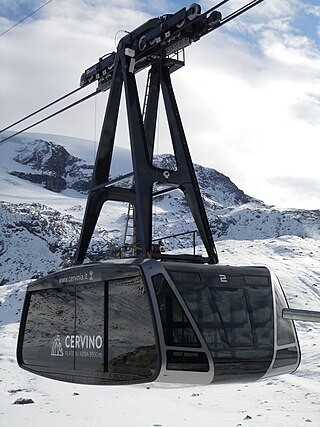
An aerial lift, also known as a cable car or ropeway, is a means of cable transport in which cabins, cars, gondolas, or open chairs are hauled above the ground by means of one or more cables. Aerial lift systems are frequently employed in a mountainous territory where roads are relatively difficult to build and use, and have seen extensive use in mining. Aerial lift systems are relatively easy to move and have been used to cross rivers and ravines. In more recent times, the cost-effectiveness and flexibility of aerial lifts have seen an increase of gondola lift being integrated into urban public transport systems.

The Glacial Aerial Tramway Kaprun III is the third section of the aerial tramway on the Kitzsteinhorn mountain at Kaprun, Austria. It was placed in service on 26 November 1966. It is currently branded Gipfelbahn.

The Masada cableway is an aerial tramway at the ancient fortress of Masada, Israel.
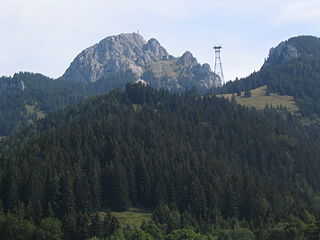
The Wendelstein Cable Car (Wendelstein-Seilbahn) is a 2,953-metre (9,688-foot) long cable car running from the village of Bayrischzell Osterhofen to Mount Wendelstein in the Bavarian Alps in Germany. It has a maximum speed of 10 m/s (32.8 ft/s) and its travel time is 6.5 minutes. The cabins each take up to 50 passengers, and the cable car system has a transport capacity of 450 people per hour. The cable car climbs an altitude difference of 932 metres.

The Schauinslandbahn is a gondola lift in the Black Forest area of Baden-Württemberg, Germany. It links a lower station in the municipality of Horben, near the city of Freiburg im Breisgau, with an upper station near the summit of the Schauinsland mountain. The line is operated by VAG Freiburg, the city transport operator for Freiburg. The same company operates that city's tram and bus network, including bus route 21 that links the lower station of the Schauinslandbahn to the terminus of tram route 2 at Günterstal.

The Rokkō Arima Ropeway is Japanese aerial lift line in Kōbe, Hyōgo, operated by Kōbe City Urban Development. Opened in 1970, the line links Mount Rokkō and Arima Onsen hot spring. The aerial lift consisted of two lines, Ura-Rokkō Line and Omote-Rokkō Line. The latter, however, is currently out of service, because users shifted to cars and buses.
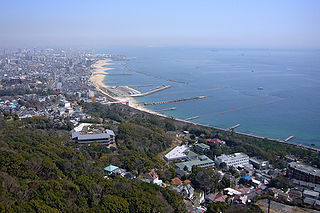
The Sumaura Ropeway is Japanese aerial lift line in Kōbe, Hyōgo, operated by the Sanyō Electric Railway. Opened in 1957, the line climbs Mount Hachibuse (246m) of the Suma coast. At the summit, there is a transfer to the Carlator, a sort of escalator with baskets. Carlator is a portmanteau of "Car" and "escalator".

The Hakone Komagatake Ropeway, officially the Komagatake Ropeway Line, is a Japanese aerial lift line in Hakone, Kanagawa, operated by Izu Hakone Railway. The line, opened in 1963, climbs Mount Koma from the Lake Ashi lakeside.
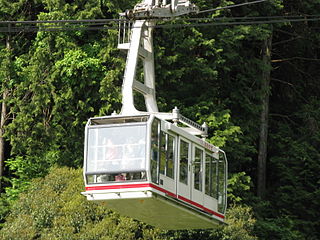
The Katsuragisan Ropeway, legally referred to as Katsuragi Ropeway Line, is an aerial tramway line in Gose, Nara, Japan. The line is the only aerial tramway line in Japan that is directly owned and operated by a major private railway company, the Kintetsu Railway. Opened in 1967, the line climbs Mount Yamato Katsuragi. Contactless smart cards PiTaPa or Surutto Kansai are not available on the line.
The Hashikurasan Ropeway is the name of Japanese aerial lift line in Ikeda, Tokushima, as well as its operator. The line climbs Mount Hashikura of Hashikura-dera, a famous temple.

The Hodosan Ropeway is Japanese aerial lift line in Nagatoro, Saitama.

The Shinhotaka Ropeway is an aerial lift system in Takayama, Gifu Prefecture, Japan, and is operated by Okuhi Sightseeing Development. The Meitetsu Group company also operates hotels in the area. Opened in 1970, the line climbs to the hillside of the Hida Mountains' Mount Hotaka, the third tallest mountain in Japan.

The Port Vell Aerial Tramway is an aerial tramway in Barcelona, Catalonia, Spain. It crosses Port Vell, Barcelona's old harbour, connecting the Montjuïc hill with the seaside suburb of Barceloneta.
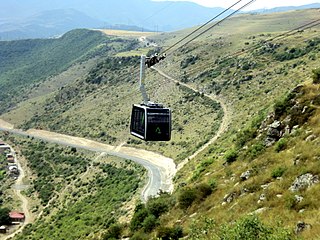
Wings of Tatev is a 5.7 km (3.5 mi) cableway between Halidzor and the Tatev monastery in Armenia. It is the longest reversible aerial tramway built in only one section, and holds the record for Longest non-stop double track cable car. Construction was finished on 16 October 2010.

The Nordhausen tramway network is a network of tramways forming part of the public transport system in Nordhausen, a city in the federal state of Thuringia, Germany.
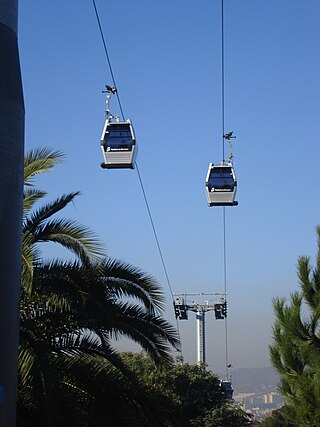
The Montjuïc Cable Car is a gondola lift in Barcelona, Catalonia, Spain. The cable car runs from a lower terminus adjacent to the Montjuïc Park upper station of the Montjuïc funicular, and climbs higher up the Montjuïc hill to a terminal near the Montjuïc Castle on the summit of the hill. At its midpoint, the line executes a 90 degree turn and the cabins pass through Mirador station, although only down-bound cabins stop at this point.

The Olympos Aerial Tram, aka Olympos Cable Car, is an aerial lift of tramway type located in Antalya Province, southern Turkey, serving the peak of Mount Olympos at an altitude of 2,365 m (7,759 ft) from Kemer. It went into service in 2006.


















